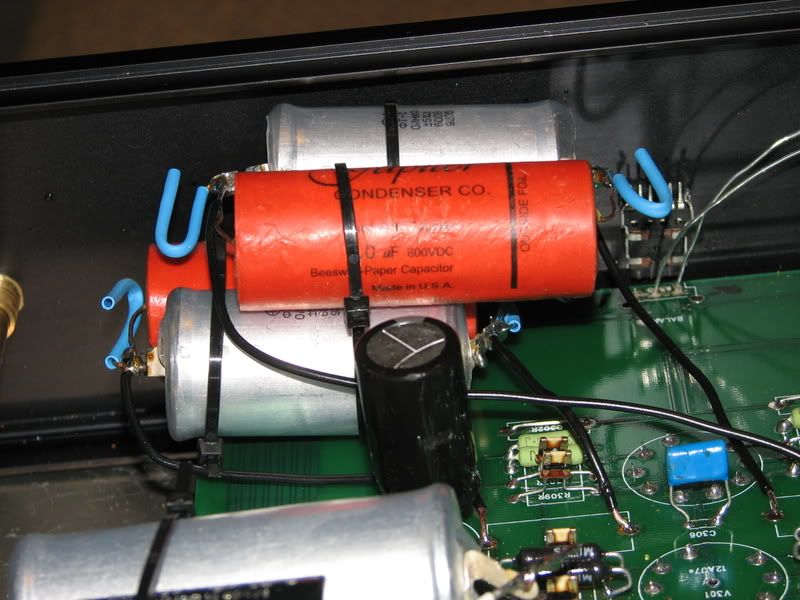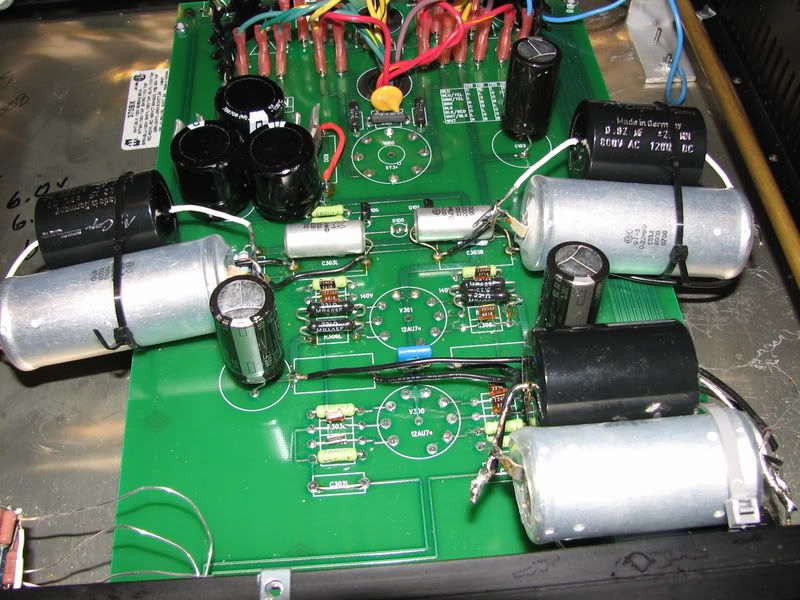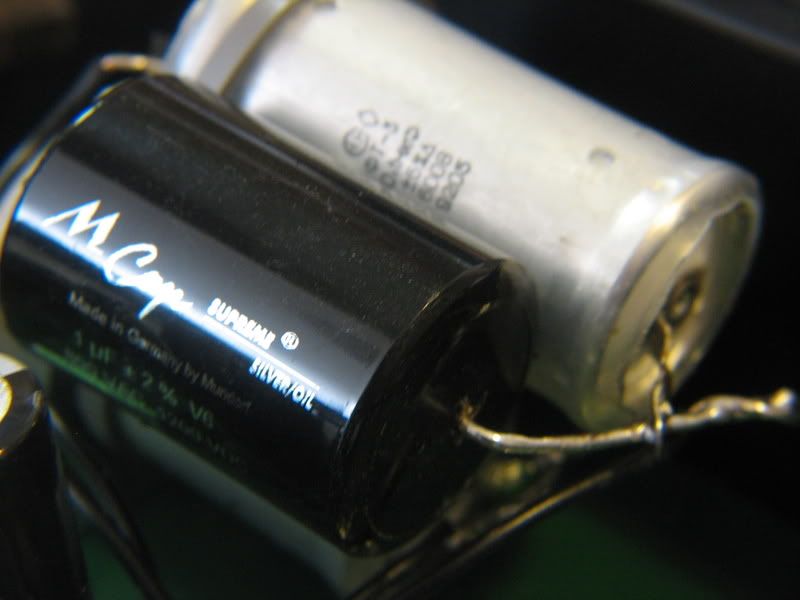I have been fighting back and forth with my Clarinet passive component pieces.
First Dynamicaps, then Mundorf SIO, then SIO with teflon, then Jupiters, then Jupiters with teflon, and then back to SIO and Teflon. I have been trying to find a cap or combination of caps that allows me to just sit back and relax like I did with the Dynamicap and teflon cap mix. However I cannot give up the Mundorf SIO caps. They are superb pieces. They added deeper bass, more space, more detail and goose bumps. I like the goose bumps the best.

Some have been asking me about the Jupiter caps I tried. I had them solo in the coupling cap position for a week. The sound was full and rich sounding. They had a weird noisy sound floor. Almost like tape hiss corrected with Dolby B or C. They exhibited expressive bass, midbass, and delivered vocal magic in spades.
However I lost a great deal of dynamics. So much so that after a week I added the .10uf teflons. The dynamics were still nowhere to be found. Worse, the Jupiters just cannot carry the highs unless you really starve the H+. If I got it down to 5.25 volts the Jupiters sounded a little more neutral from top to bottom. This effected the dynamics even more. I needed to try something different.
I went back to SIO and teflon at the coupling cap postition. However, now I was missing the deep bass and midbass of the Jupiters. What is a guy to do when you want everything? I thought why not try those Jupiters and teflons as B+ Bypass caps?

After an hour of sheer distortion out they came. This was a disaster.

I am not sure what is happening with the 327 volts going across the beeswax and aluminum, but the Jupiters just cannot take it.
My advice to you is that if you plan on trying these Jupiters keep them in the signal path. They were very happy there. In fact if your system is hot or dry these Jupiters might be one possible road to perfection. System matching is everything.
After removing the Jupiters in the B+ position I thought about trying a .47 teflon and a .47 K40Y9 PIO but I kept thinking about the space aspects of these big teflons.
I decided to try a solo pair of SIO 1.0 as the B+ bypass caps. Things sounded great. I kept thinking this is exactly what Jim Hagerman is talking about when he says every single component on his board is important. I can confirm this first hand.
Back to the coupling caps, I mentioned I am back to SIO and teflon. However this has a bit of a twist. I am using a .82uf SIO and a .22uf FT-3 cap. The dynamics picked up a lot during the two weeks of break in. The extra surface area in the larger .22 teflon allows drums and percussion to sound superb in every way. Rock and roll sounds superb and Jazz kicks up its heels. I love classical music and the .22 teflons really deliver in a big expressive way. These are not coming out!
Interesingly, the teflons in .22uf value do not do deliver the clarity in the highs as I was getting with the 1.0 SIO and 0.10uf Teflon. Perhaps the .22uf have a different sonic characteristic than the .10uf caps in regards to the highs. After two weeks of break in I recorded some stuff and compared the cdr's to the 1.0 SIO and 0.10uf teflons. I am definitely tilted down up top.
I like the bass growl from bowed string bass with the .22 teflons a lot more. I also like the dynamics more. I kept thinking why not just go back to the 1.0 SIO .10 teflon match up? It sounded great. Well I am not sure after hearing this level of dynamics I could step back. I really like the timbre of the .82 SIO with .22uf teflons.
OMalley mentioned his DAC and how using an FT-1 perked up the highs in a way he enjoyed. I decided to solder in a pair of the FT-1 0.01uf baby teflons. This does deliver more sparkle up top but without the grain and glare I got when doing this with a silver mica.

I will give these a couple more weeks before declaring anything one way or the other.
The big change is my Clarinet in my line of thinking was timbre matching the coupling caps with the B+ bypass caps. Before I had been using a K40Y9 0.22uf 400v PIO and a 0.10 teflon. The Clarinet just did not seem quite expressive as when I had been using 1.0 Dynamicaps and teflons at the coupling and the Dynamicaps and teflons at the B+. This was a great combo. However going back to Dynamicaps is not an option for me. The SIO give me the space and detail I enjoy. Their bass response is better and they have a smoothness and richness that make for goose bumps.

This is a tight fitting sandwich but it sure does deliver space, depth, and impact. I did not know the B+ was so darn criticical. It is. There is more detail but without any kind of analytical nasties. I couldn't be happier.
However there is a cost involved...the bottom line is this costs more money. The SIO 1.0 are about 75 dollars or so and the .82 are at least 65. So this is not an inexpensive tweak. I got my SIO at Parts Connexion. You can get Jupiters there as well.
If it were me trying to keep things a little more sane on the board. I would use 1.0uf with .10 teflons at both the coupling and the B+ positions. Size is better, dynamics will still be off the chart good and you probably won't need the FT-1 caps to get back some air.
I will report more as these FT-1 and .22 FT-3 caps continue to break in. Right now everything sounds better.

Cheers!